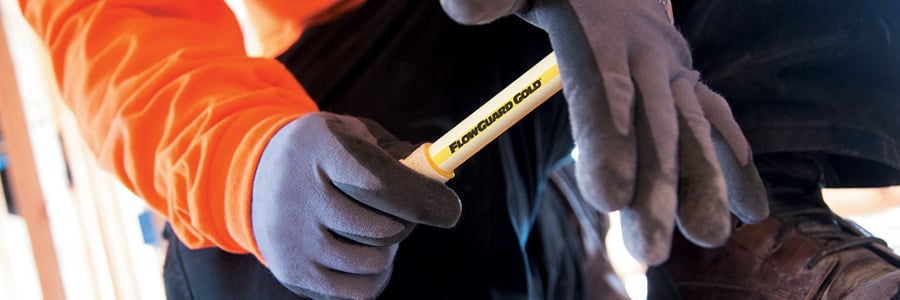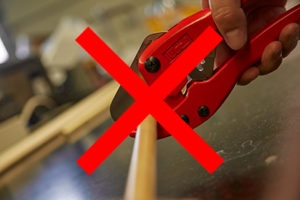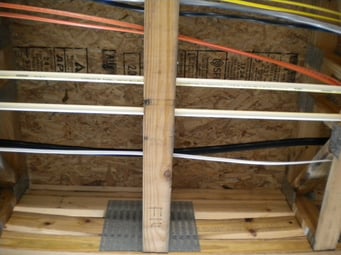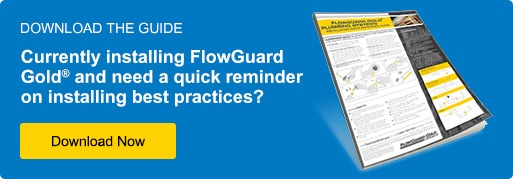
By: Jonathan Simon on April 4th, 2018
Top 10 FlowGuard Gold Installation Dos and Don'ts
With FlowGuard Gold CPVC, it’s easy to install piping systems that last. Use these 10 CPVC installation dos and don’ts to make sure that every installation is done right, preventing costly leaks and damage in the future.
DON’T pre-assemble without solvent cement
Installing pipes and fittings without using any solvent cement is known as dry fitting, and it’s sometimes done to check measurements. The problem is that it can be easy to lose track of which joints have been dry fitted during installation. Because of the extreme strength built into an interference fit, these joints may initially pass a pressure test, but over time they can fail.
DO ensure proper solvent cement coverage
Proper solvent cement coverage requires a heavy, even coat around all 360º of the pipe. Failure to ensure complete coverage can result in leak paths. Because solvent cements work by softening the surface of the pipe and fitting to create a weld, excessive application of solvent cement may cause failures. Applying too much solvent cement may result in puddling in fittings, which may weaken the fitting.
DO inspect every joint
When you visually inspect the joint, make sure that there is a continuous bead of solvent cement at the fitting. If you can’t see the bead all the way around the joint, the solvent cement may not have been applied correctly. If a joint fails your visual inspection, you should cut it out and re-do it with a new fitting.
DO allow room for expansion and contraction
CPVC piping expands and contracts in response to changes in temperature. For each 50°F temperature increase, FlowGuard Gold will expand about one inch per 50 feet of straight pipe.
DON’T restrict the pipe’s natural, lateral movement
Expansion and contraction may cause the pipe to move. Do not place hangers or straps in positions that will restrict the natural movement of the pipe. Instead, be sure to leave space between elbows and hangers or restraints.
DON’T butt-up against stationary objects
Do not butt-up elbows or tees against fixed structures like joists, studs, walls, etc. If the pipes expand due to temperature changes, the fitting will not able to move increasing the risk of excessive stress on the pipe. Always leave space to allow for expansion and contraction.
DON’T use scissor-type (PEX) pipe cutters
Scissor-style cutters are designed for flexible hoses and tubes and are not intended for use with rigid pipes. For new FlowGuard Gold installations, use ratchet cutters, wheel cutters or close quarters (c-style) tubing cutters.
DO use the right tools when cutting aged pipe
To cut into previously installed FlowGuard Gold, never use ratchet or scissor-style cutters as they may damage the pipe. A fine-tooth saw is the preferred tool for cutting into aged pipe, however a wheel cutter or close quarters (c-style) cutter may also be used under the right conditions.

DON’T install pipes in uninsulated areas
Pipes that are installed in uninsulated areas may be subjected to below-freezing temperatures. Water expands when it freezes, causing damage to all plumbing systems, regardless of their material. To avoid this risk, do not install pipes in areas without a compatible freeze protection (insulation, heat tape, etc...).
DO avoid excessive stress in the system
Stress can occur from outside or inside of a plumbing system. External stress most commonly occurs due to failure to account for thermal expansion, forcing the stresses of expansion into the pipe. Internal stress most commonly comes from extreme water pressures and temperatures, FlowGuard Gold plumbing systems are rated for pressures of 400psi at room temperature and 100psi at 180ºF, under most conditions these pressures will not be exceeded but care should be taken to avoid temperatures and pressures exceeding the pipe’s rating.
To take these tips along with you, just print one of our simple installation guides. They are available in both English and Spanish. In addition to these do’s and don’ts, they include step-by-step instructions on how to install FlowGuard Gold, as well as more details about expansion & contraction.



